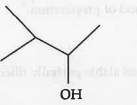Complete Solutions to Exercise of chapter Sample Paper 8 of Class 11 book with complete answers and questions
| Class 11 | CHEMISTRY |
| Chapter | Sample Paper 8 |
| OSWAAL PUBLICATION | Exercise |
| Number Of Questions | 62 |
| Academic Year | 2023-24 |
What is the SI unit of density?
00:46View SolutionWrite a single equation that combine the four measurable variables P,V,T and n.
01:59View SolutionDefine physical equilibrium.
03:32View SolutionWhich of the following has the largest size : `Na^+,Na,CI,CI^-`
03:37View SolutionName a compound in which the oxidation number of oxygen is `+1`.
02:09View SolutionWhich alkali metal does not form peroxide and superoxide?
01:39View SolutionWhat is the composition of producer gas?
01:15View SolutionWrite the formula of orthoboric acid.
04:34View SolutionWrite one application of fractional distillation.
02:12View SolutionDefine stereo-isomers.
04:52View SolutionWhat is AZT? Write its important application
02:27View SolutionWhat is AZT? Write its important application
02:27View SolutionWhich element among alkali metals is : Strongest reducing agent
02:46View SolutionWhich element among alkali metals is : Radioactive
01:23View SolutionIdentity the compounds A and X in the following reaction : `A+2HCl+5H_2Orarr2NaCl+X`
02:12View SolutionWhat is L.P.G? What is its use?
02:32View SolutionMention any two necerssaary conditions for any system to be aromatic.
02:11View SolutionWhat are primary and secondary pollutants of the air?
02:57View SolutionState modern periodic law and assign IUPAC name of element with atomic number 111.
05:19View SolutionArrange the following in increasing order their negative electron gain enthalpy: F,CI ,Br and I.
04:05View SolutionWrite three main characterestics of ionic compounds.
02:00View SolutionExplain the resonating structures of the following: `N_2O`
06:12View SolutionExplain the resonating structures of the following: `SO_2`
03:01View SolutionCalculate formal charge on sulphur atom in `SoCl_2`
03:06View SolutionDraw energy level diagram for `He-2` molecule.Calculate its bond order.
05:26View SolutionBalance the followng equation in basic medium by ion-electron method:`P_4(s)+OH^-(aq))rarrPH_3(g)+H_2PO_2^-(aq)
05:11View SolutionComplete the following equations: `PbS(s)+H_2O_2(aq)-
03:42View SolutionComplete the following equations: `CaO(s)+H_2O(g)rarr
02:22View SolutionComplete the following equations: `AICI(s)+H_2O(l)rarr
01:40View SolutionWhat is the formula of epsom salt.
01:13View SolutionHow does baking soda prepared in laboratory,write one use of it.
03:51View SolutionList two similarities between boron and silicon.
02:19View SolutionGiven any one use of silicones
01:32View SolutionDefine the terms: Mass percentage
03:15View SolutionDefine the terms : Mole fraction.
04:26View SolutionHow much copper can be obtained from 100 g of copper sulphate `(CuSO_4)?
07:33View SolutionCalculate number of protonx,neutrohns and electrons in `"_35^80Br`
02:30View SolutionWhat do you understand by photoelectric effect?
02:04View SolutionState Aufbau principle.
02:37View SolutionGive the values for all quantum numbers for 2p electrons in nitrogen (Z = 7).
03:22View SolutionState Dalton's law of partial presuures.
01:21View Solution200 ml of `SO_2` diffurse through a porous plug in 600 seconds.What volume of methane `(CH_4)` will diffuse in the same time.
04:13View SolutionWhat do you mean by isolated system ? Given an example also.
03:37View SolutionA swimming pool contains 1 x 10^6 L of water. How much energy in Joule is required to raise the temperature of water from 20^0c to 30^0c ? The specific heat capacity of water is 4.184 J/0C g^-1
09:41View SolutionExplain the enthalpy of hydration with suitable example.
04:41View SolutionDefine entropy.Calculate entropy change for the following reversible process : 1 mole of liquid water at 1 atm `100^@C` evaporates to 1 mole water vapours `(Delta_vap for H_2O=2257 jg^-1)`
04:28View SolutionWrite any two characteristics of physical equilibria.
02:32View SolutionAt equilibrium the concentration of N2 =3.0×10 −3 M,O2 =4.2×10 −3 M and NO=2.8×10 −3 M in a sealed vessel at 800 K. What will be K c for the reaction N2 +O 2 →2NO.
05:34View SolutionDefine acids and bases by Lewis concept.Write one limitation of this concept.
04:22View SolutionWhat do you mean by buffer solution.Give their types also.
07:51View SolutionSuggest a method to separate the constituents of the following mixture : Mixture of two micsible liquids.
02:23View SolutionSuggest a method to separate the constituents of the following mixture : A mixture of plant pigments.
02:23View Solutionwrite IUPAC name of the following organic compounds:
 02:19View Solution
02:19View Solutionwrite IUPAC name of the following organic compounds:
 03:51View Solution
03:51View Solutionwrite IUPAC name of the following organic compounds: `CH_3-CH=CH-CH_3`
02:05View SolutionExplain functional isomerism with example.
03:33View SolutionExplain following terms:Electron withdrawing inductive effect (-I effect)
02:38View SolutionExplain following terms: Carbocations
02:26View SolutionExplain following terms:Free radicals
02:18View SolutionHow wil you convert benzene into: m-nitrochlorobenzene?
02:33View SolutionHow will you convert benzene into: p-nitrotoluene?
07:35View SolutionExplain the mechanism of nitration of benzene .
03:24View Solution
Exercise questions and complete solutions for chapter Sample Paper 8 of OSWAAL PUBLICATION of Class 11
